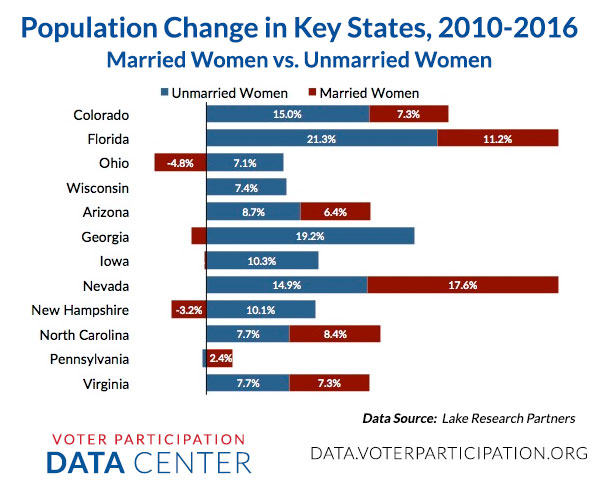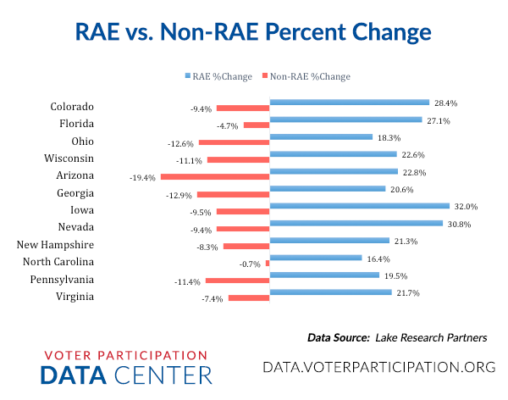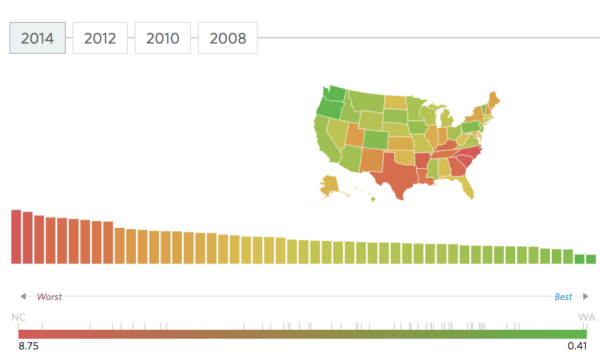New Census Data Shows a Huge Gender Gap in Income
The U.S. Census Bureau’s latest report gives undeniable evidence of “a persisting large gender gap in incomes in the United States. The fact that nearly one fifth of all family households are headed by a single woman and that these households have incomes far below the national average, is cause for major concern.”
WIAReport continues, “for single women living alone, the median income in 2015 was $29,022. For single men living alone, the median income was $40,762. Thus, single women had a median income of 71.2 percent of the median income of single men.”
Indeed, the data shows that the median income for households headed by single women in 2015 was $37,797, and that these counted for 19% of all households in America.
Washington Post: Clinton and Trump’s demographic tug of war
Which candidates are earning the support of the Rising American Electorate? The Washington Post’s new graphic gives us some insight:
The presidential contest is often compared to a horse race, with the candidates fighting to finish in first place Election Day. We offer a bit of a different metaphor here. The campaign is also a series of simultaneously fought tug-of-war matches for different demographic groups — based on gender, age and race/ethnicity among others.
Our monthly Washington Post-ABC News poll provides a glimpse into which demographic groups Hillary Clinton and Donald Trump are attracting and how that support has changed over time.
Women and the Minimum Wage, State by State
In their new interactive report, NWLC explores why raising the federal minimum wage, and protecting tipped workers, is so important to helping women in America support themselves and their families. “Why? Because women represent nearly two-thirds of minimum wage workers across the country, and more than three-quarters of minimum wage workers in some states. Today, the federal minimum wage is just $7.25 per hour, and full-time earnings of $14,500 a year leave a family of three thousands of dollars below the federal poverty line. Twenty-nine states and the District of Columbia currently have minimum wages above the federal level, but in almost every state, the minimum wage leaves a full-time worker with two children near or below the poverty level.”
“… because women are the majority of workers who would get a raise, increasing the minimum wage would also help close the gender wage gap.
Pew: This may be the last presidential election dominated by Boomers and prior generations
In a new report, Pew Research Center’s Richard Fry writes that “For the past few decades, presidential elections have been dominated by voters of the Baby Boom and previous generations, who are estimated to have cast a majority of the votes. But their election reign may end this November.”
Fry goes on to explore the demographic shifts that would make this true: “As of July, an estimated 126 million Millennial and Gen X adults were eligible to vote (56% of eligible voters), compared with only 98 million Boomers and other adults from prior generations, or 44%” of eligible voters.
What’s the problem? In one word: turnout. “We won’t know until after November if Boomers and their elders will pass the torch to Gen X and Millennials as a share of voters, but all the available data suggest that the 2016 election will mark the beginning of a new era for U.S. presidential elections.”
Great New Interactive Feature from Pew: The Elections Performance Index
The Pew Charitable Trusts have just published a new Elections Performance Index, an interactive feature with data from “the first comprehensive assessment of election administration in all 50 states and the District of Columbia.”
Using indicators for ballot access and ease of voting like voter turnout, registration rate, registration or absentee ballot problems, and voting wait time, they’ve assigned each state a percentage score for its election administration for every federal election from 2008 to 2014. In the 2014 election, the state with the best score was was North Dakota, with 84%; the bottom-scoring state was Alabama, with 49%.
In their interactive data feature, you can view each state’s scores on all of the individual indicators, a ranked list of all the states, or compare states’ scores from election to election. It’s a great tool to see how voters in many states still face significant challenges in order to raise their voice in our democracy.
How does your state stack up in Pew’s rankings? Find out here.
EPI: "Women's work" and the gender pay gap
The Economic Policy Institute took an in-depth look at the pay gap, and the factors that cause it. Finding that “Women are paid 79 cents for every dollar paid to men—despite the fact that over the last several decades millions more women have joined the workforce and made huge gains in their educational attainment,” the authors conclude that:
“The gender wage gap is real—and hurts women across the board. Too often it is assumed that this gap is not evidence of discrimination, but is instead a statistical artifact of failing to adjust for factors that could drive earnings differences between men and women. However, these factors—particularly occupational differences between women and men—are themselves affected by gender bias. Serious attempts to understand the gender wage gap should not include shifting the blame to women for not earning more. Rather, these attempts should examine where our economy provides unequal opportunities for women at every point of their education, training, and career choices.”
Pew Elections Performance Index: Voting Wait Time
The Pew Trusts’ Election Initiatives Project tracks a number of data points that provide insight into each state’s voting landscape: among these are turnout, voter registration, and the availability of online registration. One of the most telling indicators of a state’s success in managing elections is Voting Wait Time.
Although long waits can indicate excitement surrounding an election, significant variation in polling place lines across precincts and communities may mean that inefficient administration is making voting more difficult for some voters. Average wait time is one measure of the ease of voting: The less time a voter waits to cast a ballot, the more convenient the experience.
How does your state measure up? Find out at PewTrusts.org.
New Survey Shows Strong Support for Paid Family Leave Fund
Paid family leave, paid sick leave, and affordable childcare: these aren’t political talking points, they’re the sort of public policies that will allow working families – including Unmarried Women and the Rising American Electorate – to succeed in today’s economy. A new poll commissioned by the Work Family Strategy Council shows that these policies enjoy overwhelming support with American voters: “By a nearly 2-1 margin, 61 percent of voters in these states, which include Iowa, support the creation of a national paid family and medical leave fund, 69 percent support a paid sick days law, and 57 percent support increasing access to high-quality, affordable child care, according to the survey. Among Iowans polled, 63 percent said they support a national paid family and medical leave fund, while 25 percent said they oppose it.”
Other critical takeaways from the poll include:
- “Overall, a majority of voters in the 15 states believe a national paid family and medical leave fund would make the country better off, while only 26 percent think it would make the country worse off.”
- “Voters across states say they favor a law that would create a national paid family and medical leave fund: 61 percent say they favor such a law, 44 percent say they strongly favor one, while 34 percent are opposed.”
- “A strong majority of people surveyed say they face challenges when managing job, family and personal responsibilities: 63 percent of full-time workers and 67 percent of part-time workers say they would be likely to face significant economic hardship if they had to take time from their jobs without pay to care for a new child, care for a seriously ill loved one or deal with their own serious health issue.”
Read the full article at Business Record.com
Unmarried Women: Growing in Numbers and the Power to Decide 2016 Elections
There are more than 58 million single women eligible to vote this November. For the first time ever, there are more single women than married women eligible to vote, and their numbers continue to grow nationally and in key states. And as the new poll of nine battleground states conducted for Women’s Voices Women Vote Action Fund shows, single women could determine the outcome of the presidential election and U.S. Senate races down-ballot.

Chart: Rising American Electorate vs. Non-RAE Percent Change
This chart showing the growth of the Rising American Electorate – unmarried women, people of color, and Millennials – in key states between 2010 and 2016 demonstrates quite clearly how broadly and quickly the face of America is changing.

All information was provided by Lake Research Partners.



